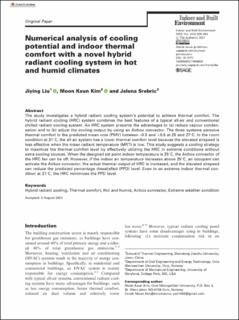Numerical analysis of cooling potential and indoor thermal comfort with a novel hybrid radiant cooling system in hot and humid climates
Peer reviewed, Journal article
Published version
Permanent lenke
https://hdl.handle.net/11250/3018803Utgivelsesdato
2021-08-27Metadata
Vis full innførselSamlinger
Originalversjon
https://doi.org/10.1177/1420326X211040853Sammendrag
The study investigates a hybrid radiant cooling system’s potential to achieve thermal comfort. The hybrid radiant cooling (HRC) system combines the best features of a typical all-air and conventional chilled radiant cooling system. An HRC system presents the advantages to (a) reduce vapour condensation and to (b) adjust the cooling output by using an Airbox convector. The three systems perceive thermal comfort in the predicted mean vote (PMV) between –0.5 and þ0.5 at 25 and 27°C. In the room condition at 31°C, the all-air system has a lower thermal comfort level because the elevated airspeed is less effective when the mean radiant temperature (MRT) is low. This study suggests a cooling strategy to maximize the thermal comfort level by effectively utilizing the HRC in extreme conditions without extra cooling sources. When the designed set point indoor temperature is 25°C, the Airbox convector of the HRC fan can be off. However, if the indoor air temperature increases above 25°C, an occupant can activate the Airbox convector; the actual thermal output of HRC is increased, and the elevated airspeed can reduce the predicted percentage dissatisfied (PPD) level. Even in an extreme indoor thermal condition at 31°C, the HRC minimizes the PPD level.

